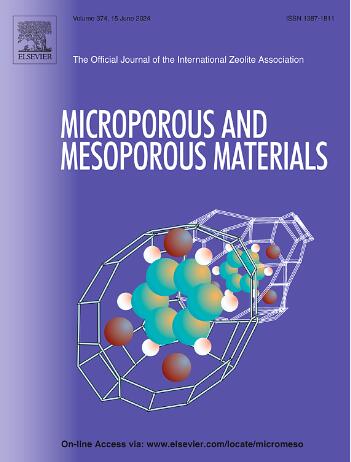Naproxen-loaded mesoporous silica nanoparticles: How can the process of incorporation affect drug placement, drug release and the in vitro naproxen irritant potential?
IF 4.8
3区 材料科学
Q1 CHEMISTRY, APPLIED
引用次数: 0
Abstract
Mesoporous silica nanoparticles (MSN) serve as versatile drug nanocarriers to avoid the interaction of highly irritant drugs with stomach mucosa, such as nonsteroidal anti-inflammatory drugs (NSAIDs). In this study, spherical and nanometric particles (181 ± 11 nm) with long-channel nanopores (∼2.5 nm in diameter) hexagonally arranged were synthesised. The NSAID naproxen (NPX) was incorporated into MSN by using the incipient wetness method. NPX ethanolic solutions of 30 mg mL−1 (NPX-ES-30) and 40 mg mL−1 (NPX-ES-40) were employed to obtain MSN-NPX30-1 and MSN-NPX40-1, corresponding to 8.26 % and 10.12 % (w/w) NPX loading, respectively. A second incorporation was performed to produced MSN-NPX30-2 and MSN-NPX40-2, with 13.45 % and 16.78 % (w/w) NPX loading, respectively. A reduction in surface area and pore volume was observed for all drug-loaded formulations compared to bare MSN. Notably, formulations prepared with NPX-ES-40 exhibited a less pronounced reduction, indicating that a portion of the drug was likely positioned outside the MSN pores. In contrast, NPX-ES-30 formulations showed efficient internalization of NPX into the mesopores, resulting in a more significant reduction in surface area and pore volume following drug incorporation. The enhanced silica–drug interaction in these formulations resulted in a slower NPX release rate compared with the NPX-ES-40 formulations, and a lower in vitro irritation score for the hen's eggs test on chorioallantoic membrane. In conclusion, the concentration of the NPX solution influenced the drug placement within MSN pores and, therefore, the NPX drug release rate and in vitro irritant potential.

求助全文
约1分钟内获得全文
求助全文
来源期刊

Microporous and Mesoporous Materials
化学-材料科学:综合
CiteScore
10.70
自引率
5.80%
发文量
649
审稿时长
26 days
期刊介绍:
Microporous and Mesoporous Materials covers novel and significant aspects of porous solids classified as either microporous (pore size up to 2 nm) or mesoporous (pore size 2 to 50 nm). The porosity should have a specific impact on the material properties or application. Typical examples are zeolites and zeolite-like materials, pillared materials, clathrasils and clathrates, carbon molecular sieves, ordered mesoporous materials, organic/inorganic porous hybrid materials, or porous metal oxides. Both natural and synthetic porous materials are within the scope of the journal.
Topics which are particularly of interest include:
All aspects of natural microporous and mesoporous solids
The synthesis of crystalline or amorphous porous materials
The physico-chemical characterization of microporous and mesoporous solids, especially spectroscopic and microscopic
The modification of microporous and mesoporous solids, for example by ion exchange or solid-state reactions
All topics related to diffusion of mobile species in the pores of microporous and mesoporous materials
Adsorption (and other separation techniques) using microporous or mesoporous adsorbents
Catalysis by microporous and mesoporous materials
Host/guest interactions
Theoretical chemistry and modelling of host/guest interactions
All topics related to the application of microporous and mesoporous materials in industrial catalysis, separation technology, environmental protection, electrochemistry, membranes, sensors, optical devices, etc.
 求助内容:
求助内容: 应助结果提醒方式:
应助结果提醒方式:


